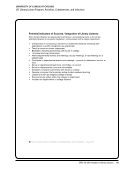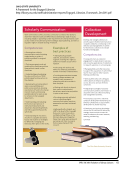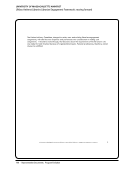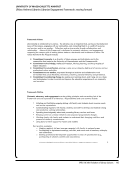SPEC Kit 349: Evolution of Library Liaisons · 75
This is an area of growth. Some librarians have attended workshops and conference programs to get more training.
We have had cross training in some areas related to data management and scholarly communication. We are
currently identifying needs and developing a longer-term plan for more targeted training in new areas to support
digital scholarship.
Training comes from supervisors (coordinators), assigned mentors, peers via shadowing or informal advice, special
training (for example from our Information Literacy unit, for best practices in BI), and access to webinars or in-house
training opportunities.
Training for academic liaisons is primarily handled by their supervisors/coordinators.
Training has been somewhat ad hoc, largely through individual mentoring. We had no new liaisons for almost a decade,
so are only now developing more formal training as we hire new librarians.
Training includes collections, instruction, reference desk, statistics keeping, etc.
Training varies across the divisions. The science division has created a training program focused on software packages
that support the research lifecycle, as well as professional development workshops on things like presentation skills.
The humanities division created a three-year training program called the Developing Librarian project focused on
“re-skilling” the humanities librarians for digital humanities work. Other divisions benefit from a part-time training
coordinator who arranges workshops, such as project management, and webinars on new skills and approaches.
We are currently launching a series of discussions and training sessions for all liaisons.
We developed a liaison checklist in 2013 that is completed in consultation with supervisors and colleagues. We promote
webinars, conference attendances, peer training, etc.
We have a well-developed training program that is customized for each new librarian.
We have developed training manuals for both collections and outreach work. The collections manual was updated in
the last c. 24 months, but the outreach manual is outdated. This latter will be updated as part of our re-examination of
the liaison program. Training is received in collection and fund management. Disciplinary coordinators and department
heads work with new liaisons to coach on methods for outreach, as well as fund management and materials selection.
Training varies according to discipline served. We hold sessions called Reference Round Tables to coach liaisons/
reference staff, and our Instruction Unit holds sessions for those liaisons who do instruction.
We provide in-person or online training for in-house knowledge areas such as data management, scholarly
communication, plagiarism, etc. We subscribe to webinars in areas of interest or training needs. We provide training
funds for outside training on new areas of responsibility. We provide funding for travel to discipline-related conferences
(in addition to library professional conferences)
We use our department meetings to discuss changes in scholarly communication. We also revamped our LibGuides
content as part of our migration to LibGuides 2.0 librarians received training on both the technological side of the
upgrade, as well as the pedagogy underlying the use of LibGuides.
Workshops on scholarly communication activities, new acquisition system, etc.
Yes, in the form of an online toolkit and some training at the departmental level. There has been minimal training
involving the use of our online ordering system, setting up profiles, and accounting issues. Plans are in place to
improve training.
This is an area of growth. Some librarians have attended workshops and conference programs to get more training.
We have had cross training in some areas related to data management and scholarly communication. We are
currently identifying needs and developing a longer-term plan for more targeted training in new areas to support
digital scholarship.
Training comes from supervisors (coordinators), assigned mentors, peers via shadowing or informal advice, special
training (for example from our Information Literacy unit, for best practices in BI), and access to webinars or in-house
training opportunities.
Training for academic liaisons is primarily handled by their supervisors/coordinators.
Training has been somewhat ad hoc, largely through individual mentoring. We had no new liaisons for almost a decade,
so are only now developing more formal training as we hire new librarians.
Training includes collections, instruction, reference desk, statistics keeping, etc.
Training varies across the divisions. The science division has created a training program focused on software packages
that support the research lifecycle, as well as professional development workshops on things like presentation skills.
The humanities division created a three-year training program called the Developing Librarian project focused on
“re-skilling” the humanities librarians for digital humanities work. Other divisions benefit from a part-time training
coordinator who arranges workshops, such as project management, and webinars on new skills and approaches.
We are currently launching a series of discussions and training sessions for all liaisons.
We developed a liaison checklist in 2013 that is completed in consultation with supervisors and colleagues. We promote
webinars, conference attendances, peer training, etc.
We have a well-developed training program that is customized for each new librarian.
We have developed training manuals for both collections and outreach work. The collections manual was updated in
the last c. 24 months, but the outreach manual is outdated. This latter will be updated as part of our re-examination of
the liaison program. Training is received in collection and fund management. Disciplinary coordinators and department
heads work with new liaisons to coach on methods for outreach, as well as fund management and materials selection.
Training varies according to discipline served. We hold sessions called Reference Round Tables to coach liaisons/
reference staff, and our Instruction Unit holds sessions for those liaisons who do instruction.
We provide in-person or online training for in-house knowledge areas such as data management, scholarly
communication, plagiarism, etc. We subscribe to webinars in areas of interest or training needs. We provide training
funds for outside training on new areas of responsibility. We provide funding for travel to discipline-related conferences
(in addition to library professional conferences)
We use our department meetings to discuss changes in scholarly communication. We also revamped our LibGuides
content as part of our migration to LibGuides 2.0 librarians received training on both the technological side of the
upgrade, as well as the pedagogy underlying the use of LibGuides.
Workshops on scholarly communication activities, new acquisition system, etc.
Yes, in the form of an online toolkit and some training at the departmental level. There has been minimal training
involving the use of our online ordering system, setting up profiles, and accounting issues. Plans are in place to
improve training.












































































































































































































